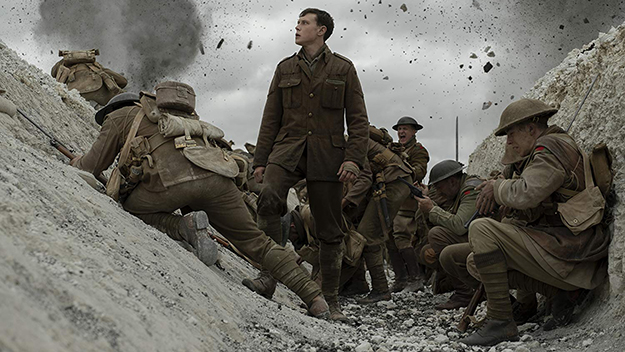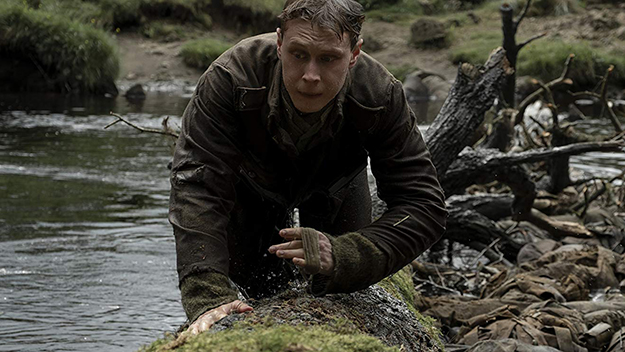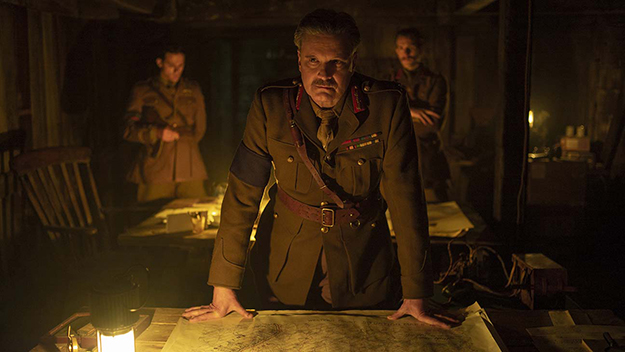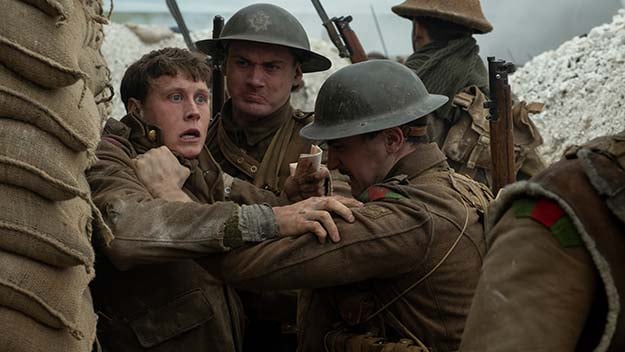Film of the Week: 1917

Images from 1917 (Sam Mendes, 2019)
The first thing I saw after emerging from a press screening of Sam Mendes’s World War One drama 1917 was a poster for the film, with the tagline, “From the Director of Skyfall.” Mendes’s film, set in the trenches and on the battlefields of Northern France, proposes to offer a vivid evocation of combat in the penultimate year of the Great War: a closing caption pays tribute to the director’s grandfather Alfred H. Mendes, who told him about his own experiences as a soldier in the conflict. Sincere as 1917 apparently is, you can’t help feeling that it is a curious tribute to real horrors endured by real combatants to turn their experience into a Skyfall of the trenches—a pulse-quickening, nonstop adventure yarn about two intrepid heroes on an altogether Bond-style mission into No Man’s Land and beyond.
George MacKay and Dean-Charles Chapman play British lance-corporals Schofield and Blake, entrusted with delivering an urgent message to commanding officers at the front—a race-against-time mission to stop an advance planned on the basis of false information that would result in a certain massacre of British troops. This is the high-stakes premise for a film that aims to be, on one hand, a meticulously realistic evocation of the war and, on the other, a rattling adventure that barely lets up from the start and is executed, moreover, in one bravura continuous shot (at least, the cleverly engineered impression of one). 1917 is pulled off with dazzling panache and more than ingenious choreography, with the ever-impressive cinematography maestro Roger Deakins pulling off some kind of personal best—if we are to apply championship terms to the art of camerawork.
The film’s journey—given that everything is about the camera’s movement, it is hard to avoid the term—begins as we accompany Schofield and Blake out of the calm of a flowery field and into a trench that slopes from the surface deep into the ground, soon filling up with crowds of soldiers that the men must push their way through. A tone of historical realism is established by the wry names that soldiers have given different stretches of trench: “Paradise Alley,” “Sauciehall Street” (after the Glasgow thoroughfare). But realism soon gives way as our heroes find themselves facing peril after peril, pulling off feats of daredevil prowess. Crossing into No Man’s Land, they—and the camera—negotiate a dense forest of barbed wire. They reach an abandoned German trench which turns out to be booby-trapped, triggering some choice dialogue: “The whole thing’s coming down!” “We need to keep going!” “It’s a mineshaft, but we have to jump!”
Later, Schofield enters an abandoned town by making his way, with an athletic leap, across a collapsed bridge; by this point, fantasy has set in so firmly that you’re surprised there isn’t a troll underneath barring his passage unless he answers three questions. This takes him into a perilous night world, a chiaroscuro desolation in which he must evade ghostly pursuers who emerge from walls of flame. At the climax, he rushes through the thick of an infantry charge, dashing perpendicular to the action, deftly evading exploding mines and dodging collisions with running men. You imagine that the film will end with a precursor of Bond’s M stepping out of the shadows, and saying, “Well done, Lance-Corporal—that was just a test.”

What gives 1917 its oddly dreamlike tone is the way that the swathes of landscape seem to change around us, in what only appears to be the real time of this (faked) plan-séquence (in fact, there are at least two breaks: one in which Schofield, and the screen, briefly black out following a blast, the other his momentary lapse into oblivion as he floats down a river). In reality, time and space are artfully contracted: it is just a few moments, and a few steps, from a stretch of trench in which order and calm reign to another in which battle-traumatized soldiers hug the walls for shelter. In another scene, we—and the two men—abruptly become aware of the noisy but hitherto-undetected arrival of British troops from offscreen—or rather, offstage, since these sudden entrances seem to be coming from the unseen wings of a vast theater.
Amid the frenzy—the film could have been called Never a Dull Moment on the Western Front—there are interludes of contrived calm. In a passage of quite staggering kitsch, Schofield drifts into a leafy grove where young soldiers sit dreamily listening to a man sing “Wayfaring Stranger.” Earlier, in the deserted town, he finds himself in a cellar with a young French woman tending a baby; he gives her his small provision of food, a gesture designed to prove his compassion, although it comes across more like the act of a protagonist in a video game, giving objects of exchange to a Non-Player Character, thereby earning points for the further voyage.
The film’s most preposterous moment comes when Schofield and Blake spot a plane approaching in the sky, clearly about to crash. It does indeed crash—exactly where the men are standing. It could have landed somewhere else, anywhere else, but no, whatever happens in the film happens right here and right now. This is a YOU ARE HERE movie, in which the viewer is always in the thick of the action.
As many critics have pointed out—whether they’re for or against the film—1917 very much resembles a video game or a virtual reality experience. The way the action slips from setting to setting, the landscape shifting with absolute fluidity from zone to zone, suggests not so much a real pre-existing landscape that we are invited to explore, but rather a series of discreet environments programmed to unfold around us, their function always determined by the need to place us at the very heart of things.

The most dubious aspect of 1917 is its attempt to make the horror of war shockingly concrete. We know the trenches were a pestilential morass, but nothing justifies the moment of crassness when Schofield accidentally puts his hand right through a corpse’s rotting chest: any sense of shocking realism is defused by mere “Eww”-inducing grossness.
It may seem a bit late in the day, given the history of cinema, to find a war film distasteful because it makes the experience of real combatants—long dead, or still living—into mere adventure. This isn’t the place to discuss whether 1917 is better or worse, more or less respectful to historical facts and lived experience, than, say, Saving Private Ryan (1996) or Dunkirk (2017), to both of which it has inevitably been compared. Nolan’s Dunkirk aimed for, and achieved, an immersive intensity but even so, while it gave you the impression of what it might have been like to be at Dunkirk, it didn’t offer you a vicarious illusion of actually being there. You rode alongside various characters who experienced the event, but because of the multiplicity of viewpoints—and an intricately fragmented multiple time-frame—there was a certain respectful propriety in the way that you were always held somewhat apart from the moment, and from the people who lived it.
1917, by contrast, places you so relentlessly in the heat of events—making the action somehow subservient to your best-seat-in-the-house position—that it feels as if the war has been laid on especially for your benefit. This sort of immersive identification—in which the protagonist becomes our mere surrogate or avatar—is what, for me, makes 1917 such a rebarbative viewing experience.
Mendes is one of several filmmakers who have recently taken the art of long takes—or illusory single takes—to competitive new levels. Some viewers and critics have found this sort of artifice narcissistic, or simply an irritant, detracting from a film’s believability. Personally, I’m open to the spell of such techniques, whether or not the aim is immersiveness or enhanced identification. Alfonso Cuarón’s Gravity (2013)—at least, when seen in 3D on a huge cinema screen—achieved something quite unprecedented, creating the illusion of lifting the viewer bodily, moving us through unbounded space. Sebastian Schipper’s Victoria subjected us to the rush of its heroine’s experience as her night on the town went haywire; it worked brilliantly because we were not just caught up in events but also perplexed as they proceeded as if autonomously at their own pace. We never felt, as in 1917, that they were engineered for our pleasure (even if, realistically, they were).

Other films have had more serious intentions. Erik Poppe’s Utøya: July 22 (2018) followed one young woman through the massacre on the Norwegian island Utøya in 2011; it immersed us in her experience, but made that experience partial and frighteningly unreadable. The film could have felt morbidly exploitative, but instead came across as a serious act of ritual solidarity with the dead and the survivors. Another Norwegian one-take enterprise, Tuva Novotny’s Blind Spot (2018), follows a teenage girl home from school, then shifts to her parents as they face the aftermath of her sudden suicide attempt: the intensity of the moment overrides the alienating effect of our awareness that time and space are being manipulated.
Novotny’s title Blind Spot perhaps points to what makes some of these films more human, less intrusive than others. It lies in our being made aware that certain elements in a drama are not—perhaps should not be—available to us as spectacle. It’s the use of blind spots, obscurities, veiled events rather than visibility that make László Nemes’s 2015 Son of Saul (executed in 85 shots of varying lengths) such a revealing addition to Holocaust cinema: the film brings us close to the protagonist, but never allows us the false privilege of seeing what he sees. We are allowed to accompany him, but never (mercifully) to overstep the decent appropriate limits of identification.
However well-intentioned its spectacle, 1917 feels fundamentally wrong—disrespectful to a historical reality in its very attempts to evoke it. The classic text about the danger of overstepping the mark in this way is Jacques Rivette’s 1961 Cahiers du Cinéma piece “On Abjection,” in which he ferociously condemned a certain tracking shot in Gillo Pontecorvo’s Holocaust drama Kapò (1960). Rivette comments: “There are things that should not be addressed except in the throes of fear and trembling; death is one of them, without a doubt; and how, at the moment of filming something so mysterious, could one not feel like an imposter?”
1917 is a glum reminder that the combination of CGI and other new techniques of immersiveness are causing commercial cinema increasingly to give up on eliciting the viewer’s ability to envision, to suppose, to speculate—something that was once done by invoking discontinuities, gaps, blind spots, things that can’t or shouldn’t or don’t need to be shown. I wouldn’t go so far as to accuse Sam Mendes of “abjection,” given the apparent sincerity of his intentions. But in 1917, he approaches the memory of the Great War in a spirit that is entirely to do with spectacle and thrill, and next to nothing to do with fear or trembling, let alone the viewer’s creative imagination.
Jonathan Romney is a contributing editor to Film Comment and writes the Film of the Week column. He is a member of the London Film Critics Circle.







